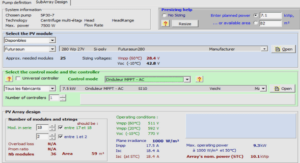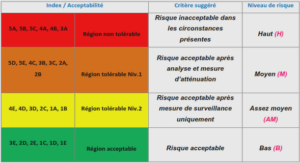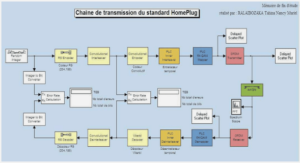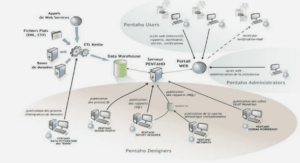Influence de l’aquaculture sur l’environnement benthique
Materials and metbods
Study area
Grande-Entrée lagoon (GE) is located in the northeast part of the Îles-de-Ia- Madeleine, Québec, Canada (Figure 8a). The surface area of the lagoon is 58 km2 and the mean depth is 3 m (Koutitonsky et al., 2002). A navigation channel separates the lagoon into a shallow (1 to 3 m) sandy area to the west and a relatively deep (5 to 7 m) muddy basin to the east (Koutitonsky et al., 2002; Figure 8b). An amphidromic point close to the Îles-de-Ia-Madeleine decreases the influence of the tide, which has a mean amplitude of 0.58 m (Koutitonsky et al., 2002). In the Îles-de-la-Madeleine, it is frequently windy and wind speeds can reach 15 m S-I (Souchu et al., 1991). As a result, the water column tends to be weIl mixed (Souchu et al., 1991). West of the channel, CUITent speeds up to 20 cm S-I have been recorded vs. 5 cm S-I in the deeper eastem zone (Koutitonsky et al., 2002). Water residence time in the lagoon deeper areas ranges between 20 and 35 days when tidal- and wind-driven currents are considered (Koutitonsky and Tita, 2006). However, it significantly decreases in winter (> 40 days) when ice-cover (December to April-May) prevents any wind influence on the lagoon hydrology (Koutitonsky and Tita, 2006). In the lagoon, water temperatures rise on average from goC in June to 20°C in the third week of August before decreasing to ca. 9°C by October (Koutitonsky et al., 2002). Salinity is about 30-31 from May to August (Souchu et al., 1991). Chiorophyll a concentration ranges between 0.5 and 2 /-lg L-1 (Roy et al., 1991).
Figure 8: (a) Maps of the Îles-de-Ia-Madeleine. (b) Location of aquaculture farms and experimental sites in Grande-Entrée lagoon. The black bold polygon indicates the mussel fann location. The two black hatched quadrants indicate scallop farms. The southem scallop farm was inactive whereas the northern farm was productive in 2003. The ellipses indicate the four experimental sites: control 1 (Cl), control 2 (C2), l-yr-old mussel (Ml) and 2-yr-old mussel (M2). The dark grey area represent the channel, the grey areas illustrate deeper zone (mean of 6 m).Because of the absence of rivers, rainfalls are the only freshwater inputs (Souchu and Mayzaud, 1991). Atmospheric input has been shown to contribute significantly to the inorganic nitrogen cycle (Souchu and Mayzaud, 1991). The lagoon system exhibits oligotrophic characteristics: nutrient inputs cou Id originate mainly from recyc1ing resulting from bacterial remineralization and excretion by heterotrophic organisms (Souchu et al., 1991).
Since 1985, the mussel industry has exploited GE (Souchu et al., 1991). Before 2001 , suspended mus sel hnes were deployed in the majority of the deepest zones of the lagoon (Figure 8b). Few deep zones were never exploited by aquaculture (e.g. east zone of the navigation channel; Figure 8b). Since 2001, the mus sel farm was separated in two distinct zones sustaining one-yr-old (Ml: 12 to 14 month old) or 2-yr-old (M2: 24 to 26 months old) mussel hnes (Figure 8b). The latter were replaced by juveniles (0+) each fallfollowing harvest. The mean mus sel size was about 4 cm for Ml vs. 6 cm for M2 between 5 and Il August 2003. At this time, the mussel dry weight (DW, with sheIls) per meter of hne was 1293 ± 212 g DW.m-1 for Ml vs. 1657± 374 g DW m-1 for M2. In 2003, a total of 318 suspended mussel hnes representing 114 km cumulative length were present in the lagoon over a 250 ha surface area (G. Tita pers. corn.). The hnes were separated from each other by 20 m . Annual mussel production reached 180 t in 2003 . Since the end of the 1990′ s, two scallop-farming zones (Placopecten magellanicus) have been selected in Grande-Entrée lagoon. However, the southem site (130 ha) has never been active whereas the northem one (100 ha) has been productive between 1999 and 2004 (Figure 8b; G. Tita pers. corn.). During these years, the northem site was occupied by suspended hnes bearing a total number of scallops ranging from 1.5 to 3 million individuals (3 age classes; G. Tita pers. corn.).
Experimental design
In situ mensurative experiments (sensu Hulbert, 1984), called hereafter experiments, were performed in the GE during the warmest months of the year. In 2003, experiments were carried out between 20 and 26 July, 18 and 23 August, and 7 and 15 September (hereafter July, August and September). Experiments were performed at 4 different sites: 1- yr-old mussel lines (Ml), 2-yr-old mussel lines (M2), and two control sites which were never exploited by aquaculture (Cl and C2; Figure 8b). In contrast to many studies (Baudinet et al., 1990; Grenz et al., 1992; Hatcher et al., 1994; Grant et al., 1995, Mazouni et al., 1996), two control sites were selected rather than one to test exclusively the influence of aquaculture with no confounding factor (Underwood, 1996). According to several authors (Dahlback and Gunnarson, 1981; Mattsson and Lindén, 1983), the influence of bivalve biodeposition would be restricted to a radius of20 to 40 m around the farms. In GE, the mean estimated dispersal of faecal pellets ranges from 0 – 7.4 m (2-yr-old mussel) to 7 – 24.4 m (l-yr-old mussel; Callier et al., 2006). During strong wind events, whereas the CUITent velo city reaches 18 cm.s-1 , the estimated dispersion may be up to 19.4 m (M2) and 24.1 m (Ml) (Callier et al., 2006). The control sites were located at more than 500 m of aquaculture sites (Figure 8b) to avoid the influence of mussel biodeposition on the benthic environment. Control sites were separated from each other by more than 500 m. Mean depth (± SE) of experimental sites was 6.14 ± 0.08 m. Experiments were haphazardly carried out within sites and among sites to integrate the spatial and temporal variability of our measurements in the whole data set. Three replicates were carried out per site and per date. The total number of in situ experiments was 36 (4 treatments, 3 dates, 3 replicates).
Field measurements
Benthic chambers (see Introduction and Figure 7; Boucher and Clavier, 1990; Thouzeau et al., in press) were used to measure biogeochemical fluxes at the watersediment interface rather than peeper and core techniques which are less appropriate (Balzer et al., 1983; Grenz et al., 1991a). We used dark chambers instead of clear ones to avoid recording photosynthetic activity (Lerat et al., 1990), since this study focussed on the comparison of benthic respiration and nutrient regeneration rates between mussel sites and control sites. Benthic chambers were composed of an acrylic tube and a removable acrylic hemisphere. Large enclosures (50 cm diameter) were selected to limit perturbation of the biogeochemical processes due to the insertion of the base into the sediment, which could damage fauna, funnels and burrows (Glud and Blackburn, 2002). Moreover, the use of large benthic chambers minimizes the effects of spatial heterogeneity in benthic fauna distribution (Balzer et al., 1983). In addition, the large water volume in the chambers (66 to 78 L depending on base insertion) allows to avoid or limit the increases in biogeochemical fluxes caused by confinement or water warrning. Each benthic chamber was delicately put into the sediment by SCUBA divers. The incubation time was set at three hours after a pilot study determined the ideal incubation time to allow ammonium fluxes to be measured and to reach final oxygen concentrations that were not lower than 80% of the initial concentrations (Richard et al., 2006). Each benthic chamber was linked to a submersible pump and to an YSI 6600 probe. The adjustable submersible pumps connected to waterproof batteries provided homogenization of the water in si de the enclosures without noticeable particle resuspension. Water flow in each chamber was adjusted to 2 L min-l, allowing stable measurements to be recorded by the YSI probe (Richard et al., 2006, Thouzeau et al., in press). The latter recorded oxygen concentration (mg L-1 ± 0.01), temperature (OC ± 0.01) and salinity (± 0.01) in the chamber at 1-min interva1s. This monitoring allowed us to verify if there were any changes in the experimenta1 conditions that could modify the biogeochemica1 processes in the chamber (e.g. an increase in water temperature).
Water samples were collected using 60-ml syringes every 90 minutes (start, midd1e and end of incubation) for nutrient analyses (ammonium, silicate, phosphate, nitrate and nitrite). Three syringes were filled at each sampling time to minimize the variability of nutrient concentrations. At the end of the incubation, the hemisphere was delicately pulled off the base. SCUBA divers used 60 ml disposab1e syringes whose ends had been cut offto collect six sediment samples for analysis of the organic matter contained in the top 2 cm. A large sediment core, whose surface area was 262.5 cm2 (Wildish et al., 2003), was also collected by SCUBA divers to identify the macrofaunal community.
Sample processing
Sediment organic matter characteristics
Three samples of the top 2 cm of sediment were dried separately at 60°C for 48 to 72 hours, weighed, and burned for 4h at 450°C to calculate the ash-free dry weight (AFDW) of the sediment (Byers et al., 1978). Sediment AFDW was measured to the nearest 10-5 g with an AG285 Mettler Toledo balance. Sediment organic matter content is expressed as percent to the total sediment weight. The three other samples of the top 2 cm of sediment were analyzed for particulate organic carbon (POC) and particulate organic nitrogen (PON) contents with a Carlo Erba NC 2500 elementary analyzer. Finally, POC: PON ratios were calculated.
Macrofauna community
In the field, macrofauna samples were washed over a 0.5 mm sieve and frozen at – 18°C. At the laboratory, samples were thawed and organisms were counted to calculate total macrofaunal abundance. Samples were then dried at 60°C for 48 to 72 hours and weighed to obtain total macrofauna biomass (dry weight; mg). The dry mass was measured to the nearest 10-5 g with an AG285 Mettler Toledo balance. Abundance and biomass were standardized to one square metre.
Nutrients analyses
Ten millilitres per synnge were immediately sampled in the field to measure ammonium concentration according to the OP A method (Holmes et al., 1999) with an Aquafluor handheld Turner Designs fluorometer. Because of technical problems in July, ammonium measurement was performed only in August and September. The remaining water samples were stored in three cryovials and frozen (-80°C) after filtering through 0.2 /lm cellulose acetate Target syringe filters. Analyses for dissolved nitrate, nitrite, phosphate and silicate were performed on a II P AA II Brann + Luebbe auto-analyzer according to Tréguer and Le Corre (1975).
Flux and ratio calculations
Oxygen consumptions were determined from the slopes of the linear regressions established between concentration and incubation time. Nutrient fluxes were estimated from the change in nutrient concentration over the incubation time. Fluxes were reported to the chamber volume and surface area. Ammonium, nitrate and nitrite concentrations were surnmed to calculate total nitrogen concentration for each treatment and date at the beginning (T 0) and at the end (T 3h) of each incubation. Initial and final NIP and SilN ratios were calculated in atomic equivalents in August and September whereas SilP ratios were calculated for aIl dates.
Statistical treatment
Analyses of variance (ANOVAs) were performed to compare (1) the characteristics ofbottom water (temperature, salinity and oxygen concentration), sediment (organic matter content, POC:PON ratios) and macrofauna (biomass and abundance; Table 3), and (2) biogeochemical fluxes (oxygen consumption and nutrient fluxes; Table 4) among the four treatments (TR: Cl , C2, Ml and M2) and three dates (Da: July, August and September with the exception of ammonium fluxes: August and September only). A final series of ANOVAs were also performed to compare nutrient ratios among the four treatments (Cl, C2, Ml and M2), different dates (July, August and September for SiIP; August and September for NIP and SilN) and two incubation times (Ti: To and T3h; Table 5). Cochran’s Test was used to verify homogeneity of the variances (Underwood, 1997); when required, data were transformed (see Table 3 – Table 5). When a source of variation was significant, SNK pair-wise multiple comparison tests were carried out to identify the differences.
Results
Bottom-water characteristics
Table 3: Results of the analyses of variance (ANOVAs) testing the effect oftreatment (TR: Control 1, Control 2, 1-yr-old mussel and 2-yr-old mussel sites), date (Da: July, August, September), and their interaction (TR x Da) on bottom water (temperature, salinity and oxygen concentration), sediment (organic matter content OM and POC:PON ratios) and macrofauna (biomass, abundance) characteristics (***: p < 0.001, **: p < 0.01,*: p < 0.05)
|
Table des matières
REMERCIEMENTS
AVANTS-PROPOS
RESUME
ABS TRA. CT
TABLE DES MA TIÈRES
LIS TE DES T ABLE A UX
LIS TE DES FI GURES
INTRODUCTION GÉNÉRALE
1.1 L’aquaculture d’hier à aujourd’hui
1.1.1 Histoire de l’aquaculture
1.1.2 Expansion de l’ aquaculture
1.1.3 Techniques d’aquaculture
1.2 Influence de l’aquaculture sur l’environnement
1.2 .1 Influence de l’aquaculture sur l’environnement benthique
1.2.2 Influence de l’aquaculture sur l’ environnement pélagique
1.2.3 Influence de l’ aquaculture dans le couplage pelagos-benthos
1.3 Étude spécifique de l’influence de l’aquaculture aux Îles-de-Ia-Madeleine
1.3.1 Mise en situation: vers un développement durable au Canada
1.3.2 Sites d ‘études : Les Îles-de-Ia-Madeleine
1.3.3 Objectifs
1.3.4 Matériel et méthodes
CHAPITRE 1: SUMMER INFLUENCE OF 1- AND 2-YR-OLD MUSSEL CULTURES ON BENTHIC FLUXES IN GRANDE-ENTRÉE LAGOON
RESUME
ABSTRACT
2.1 Introduction
2.2 Materials and methods
2.2.1 Study area
2.2.2 Experimental design
2.2.3 Field measurements
2.2.4 Sample processing
2.2.5 Flux and ratio calculations
2.2.6 Statistical treatment
2.3 Results
2.3.1 Bottom -water characteristics
2.3.2 Sediment organic matter characteristics
2.3.3 Macrofauna community
2.3.4 Biogeochemical fluxes
2.3.5 Nutrient ratios
2.4 Discussion
2.4.1 Influence of suspended mussellong lines
2.4.2 Summer variability
CHAPITRE 2: INFLUENCE OF SUSPENDED MUSSEL LINES ON THE BIOGEOCHEMICAL FLUXES IN ADJACENT WATER
RESUME
ABSTRACT
3.1 Introduction
3.2 Materials and methods
3.2.1 Experimental system
3.2.2 Experimental design
3.2.3 Incubation protocol
3.2.4 Physico-chemical measurements and sample collections
3.2.5 Laboratory processing
3.2.6 Data standardisation
3.2.7 Statistical analyses
3.3 Results
3.3.1 Environrnental conditions
3.3.2 Associated fauna with mussels
3.3.3 Oxygen consumption
3.3.4 Nutrient fluxes
3.3.5 Mussel metabolic rates and condition index
3.3.6 Variations ofnutrient ratios
3.4 Discussion
3.4.1 Influence of mussel metabolism on biogeochemical fluxes in water
3.4.2 Influence ofthe AFOM complex on biogeochemical fluxes
3.4.3 Influence ofmussellines on nutrient pools and ratios
CHAPITRE 3
RESUME
ABSTRACT
4.1 Introduction
4.2 Methods
4.2.1 Study area
4.2.2 Study shellfish cultures
4.2.3 Experimental design
4.2.4 Experimental chambers
4.2.5 Physico-chemical measurements and sample colleetions
4.2.6 Sample processing
4.2.7 Flux ea1culation and standardization
4.2.8 Statistical analyses
4.3 Results
4.3.1 Influence of mussel and scallop cultures on the pelagie environment
4.3.2 Influence ofmussel and scallop cultures on the benthic environment
4.3.3 Pelagie vs. benthic interfaces
4.4 Discussion
4.4.1 Influence ofmussel and scallop cultures on the pelagie environment
4.4.2 Influence ofmussel and scallop cultures on the benthic environment
4.4.3 Pelagie vs. benthic interfaces: relative contributions and roles
DISCUSSION GENERALE
5.1 Influence de l’aquaculture sur l’environnement benthique
5.1.1 Récapitulatif des résultats obtenus
5.1.2 Comparaison des systèmes benthiques lagunaires
5.2 Influence de l’aquaculture sur l’environnement pélagique
5.3 Contribution et rôle des structures aquacoles dans les principaux cycles biogéochimiques au sein des cultures
5.3.1 Récapitulatif des principaux résultats obtenus
5.3.2 Influence des structures aquacoles selon l’échelle spatiale d’étude
5.3.3 Variation estivale .
CONCLUSION GÉNÉRALE
PERSPECTIVES
7.1 Approfondissement de l’ étude
7.1.1 Environnement benthique
7.1.2 Influence pélagique et contribution dans les cycles biogéochimiques
7.2 Perspectives de recherches complémentaires
7.2.1 Attraction des prédateurs de la mégafaune
7.2.2 Développement de végétaux
7.2.3 Spatialisation et saisonnalité des cycles biogéochimiques
ANNEXES
BIBLIOGRAPHIE
![]() Télécharger le rapport complet
Télécharger le rapport complet






